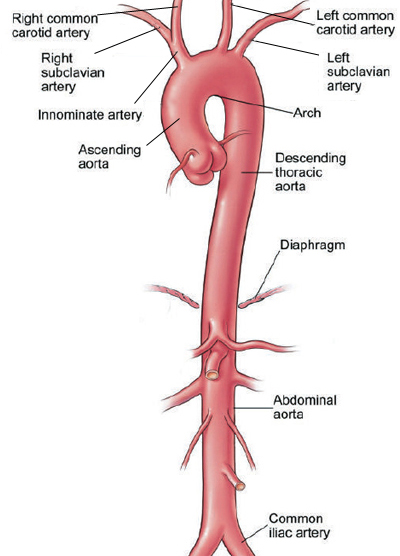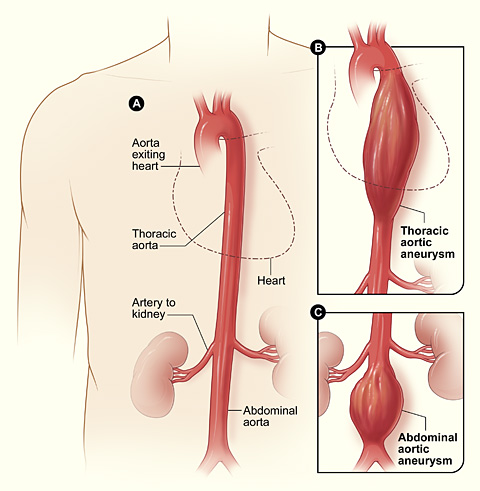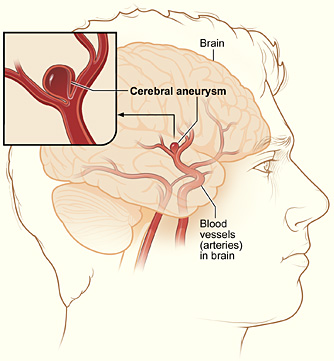The aorta is the largest artery in the body and is the blood vessel that carries oxygen-rich blood away from the heart to all parts of the body. The section of the aorta that runs through the chest is called the thoracic aorta and, as the aorta moves down through the abdomen it is called the abdominal aorta.
An aneurysm is an abnormal widening or ballooning of a portion of an artery due to weakness in the wall of the blood vessel. Aneurysms may occur in different parts of your body, like your brain, chest, abdomen as well as a variety of other places:
There are two types of aortic aneurysm possible, as well as aneurysms in other parts of your body:
Thoracic aortic aneurysm (TAA)
An aneurysm that occurs in the part of the aorta that’s located in the chest and above the diaphragm is called a thoracic aortic aneurysm. TAAs account for 1 in 4 aortic aneurysms.
Abdominal Aortic Aneurysms (AAA)
An aneurysm that occurs in the part of the aorta that’s located in the abdomen is called an abdominal aortic aneurysm. AAAs account for 3 in 4 aortic aneurysms. They’re found more often now than in the past because of computed tomography (to-MOG-rah-fee), or CT, scans done for other medical problems.
Small AAAs rarely rupture. However, an AAA can grow very large without causing symptoms. Thus, routine checkups and treatment for an AAA are important to prevent growth and rupture.
Brain Aneurysms
When an aneurysm occurs in an artery in the brain, it’s called a cerebral aneurysm or brain aneurysm. Brain aneurysms also are sometimes called berry aneurysms because they’re often the size of a small berry.
The illustration shows a typical location of a brain (berry) aneurysm in the arteries supplying blood to the brain. The inset image shows a closeup view of the sac-like aneurysm.
Most brain aneurysms cause no symptoms until they become large, begin to leak blood, or rupture. A ruptured brain aneurysm causes a stroke.
Peripheral Aneurysms
Aneurysms that occur in arteries other than the aorta and the brain arteries are called peripheral aneurysms. Common locations for peripheral aneurysms include the popliteal (pop-li-TE-al), femoral (FEM-o-ral), and carotid (ka-ROT-id) arteries.
The popliteal arteries run down the back of the thighs, behind the knees. The femoral arteries are the main arteries in the groin. The carotid arteries are the two main arteries on each side of your neck.
Peripheral aneurysms aren’t as likely to rupture or dissect as aortic aneurysms. However, blood clots can form in peripheral aneurysms. If a blood clot breaks away from the aneurysm, it can block blood flow through the artery.
If a peripheral aneurysm is large, it can press on a nearby nerve or vein and cause pain, numbness, or swelling.
Causes, incidence, and risk factors
High blood pressure, high cholesterol, and cigarette smoking may raise your risk of certain types of aneurysms. High blood pressure is thought to play a role in abdominal aortic aneurysms. Atherosclerotic disease (cholesterol buildup in arteries) may also lead to the formation of some aneurysms.
Symptoms
The symptoms depend on the location of the aneurysm. If the aneurysm occurs near the body’s surface, pain and swelling with a throbbing mass is often seen.
Aneurysms within the body or brain often cause no symptoms unless it gets to be too big and threatens to rupture. If an aneurysm ruptures, pain, low blood pressure, a rapid heart rate, and lightheadedness may occur. The risk of death after a rupture is high.
Tests used to diagnose an aneurysm include:
- CT scan
- Ultrasound
- Angiograms
Treatment
Surgery is generally recommended. The type of surgery and when you need it depends on your symptoms and the size, type and location of the aneurysm.
Prognosis
With successful surgical repair, the outlook is often excellent and often more associated with other factors such as high blood pressure etc.
Complications
The main complications of aneurysm include:
- Compression of nearby structures such as nerves, which may lead to weakness and numbness (most common with aneurysms that occur in the artery behind the knee)
- Infection, can lead to body-wide illness and rupture
- Rupture, which can cause massive bleeding that may lead to death
- Rupture of brain aneurysms can cause stroke, disability, and death. For more information, see: Cerebral aneurysm
Prevention
- Control of high blood pressure may help prevent some aneurysms. Following a healthy diet, getting regular exercise, and keeping your cholesterol at a healthy level may also help prevent aneurysms or their complications.
- Do not smoke. If you do, quitting will lower your risk of an aneurysm.
(Adapted from: National heart, lung and blood institure)



